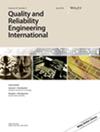A new kid on the block: The stratification pattern for space‐filling, with dimension by weight tables
IF 2.8
3区 工程技术
Q3 ENGINEERING, INDUSTRIAL
引用次数: 0
Abstract
Designs for computer experiments in quantitative factors use columns with many levels. Filling the experimental space is their most important property, and there are many criteria that assess aspects of space‐filling. Recently, Tian and Xu proposed a stratification pattern for assessing the stratification‐related space‐filling properties of designs for quantitative experimental variables whose number of levels is a power of a – usually small – integer. Such designs have been named GSOAs, in generalization of the earlier proposal of strong – or stratum – orthogonal arrays (SOAs). Latin hypercube designs (LHDs) with a suitable number of levels are special cases of GSOAs. Tian and Xu proposed to use the stratification pattern as a means to ranking (G)SOAs. They reported a small simulation study in which arrays that fared well in that ranking performed well in predicting an unknown function. Shi and Xu refined the criterion and also demonstrated success of a design that fares well on their refined criterion. This paper explains the ideas behind the stratification pattern and the related ranking criteria. A practical example and several toy examples aid the illustration. The stratification pattern can be calculated using the R package SOAs, which does not only provide the pattern itself but also provides more detail in a dimension by weight table, in the spirit of the refinement by Shi and Xu.新来的孩子空间填充的分层模式,按权重表划分维度
定量因素的计算机实验设计使用具有多个层次的列。填充实验空间是其最重要的特性,有许多标准可以评估空间填充的各个方面。最近,田(Tian)和徐(Xu)提出了一种分层模式,用于评估与分层相关的定量实验变量设计的空间填充特性。此类设计被命名为 GSOA,是对早先提出的强正交阵列(SOA)或分层正交阵列(SOA)的概括。具有适当层数的拉丁超立方设计(LHD)是 GSOA 的特例。Tian 和 Xu 提议使用分层模式对 (G)SOA 进行排序。他们报告了一项小型模拟研究,结果表明在该排序中表现出色的阵列在预测未知函数时表现出色。Shi 和 Xu 改进了这一标准,并展示了在他们改进的标准中表现良好的设计。本文解释了分层模式和相关排序标准背后的理念。一个实际例子和几个玩具例子有助于说明问题。分层模式可以使用 R 软件包 SOAs 计算,该软件包不仅提供了模式本身,还根据 Shi 和 Xu 所做改进的精神,在按权重划分的维度表中提供了更多细节。
本文章由计算机程序翻译,如有差异,请以英文原文为准。
求助全文
约1分钟内获得全文
求助全文
来源期刊
CiteScore
4.90
自引率
21.70%
发文量
181
审稿时长
6 months
期刊介绍:
Quality and Reliability Engineering International is a journal devoted to practical engineering aspects of quality and reliability. A refereed technical journal published eight times per year, it covers the development and practical application of existing theoretical methods, research and industrial practices. Articles in the journal will be concerned with case studies, tutorial-type reviews and also with applications of new or well-known theory to the solution of actual quality and reliability problems in engineering.
Papers describing the use of mathematical and statistical tools to solve real life industrial problems are encouraged, provided that the emphasis is placed on practical applications and demonstrated case studies.
The scope of the journal is intended to include components, physics of failure, equipment and systems from the fields of electronic, electrical, mechanical and systems engineering. The areas of communications, aerospace, automotive, railways, shipboard equipment, control engineering and consumer products are all covered by the journal.
Quality and reliability of hardware as well as software are covered. Papers on software engineering and its impact on product quality and reliability are encouraged. The journal will also cover the management of quality and reliability in the engineering industry.
Special issues on a variety of key topics are published every year and contribute to the enhancement of Quality and Reliability Engineering International as a major reference in its field.

 求助内容:
求助内容: 应助结果提醒方式:
应助结果提醒方式:


